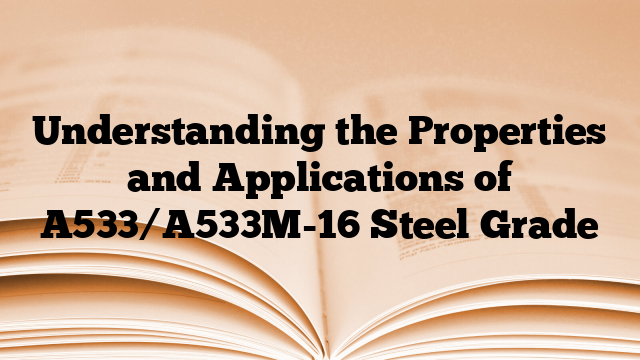ASTM A533/A533M-16 is a specification for pressure vessel plates, heat-treated, manganese-molybdenum and manganese-molybdenum-nickel alloy steel plates intended for use in welded pressure vessels. The steel grade A533 Type B is a low alloy steel that contains manganese and molybdenum as alloying elements. A533 Type B is known for its high yield strength and good notch toughness.
The chemical composition of A533 Type B steel includes the following elements:
– Carbon (C): up to 0.25%
– Manganese (Mn): 1.15-1.50%
– Phosphorus (P): up to 0.035%
– Sulfur (S): up to 0.035%
– Silicon (Si): 0.15-0.40%
– Nickel (Ni): 0.45-0.60%
– Molybdenum (Mo): 0.45-0.60%
– Copper (Cu): up to 0.35%
– Chromium (Cr): up to 0.25%
The mechanical properties of A533 Type B steel are as follows:
– Yield strength: 414 MPa (60 ksi) min
– Tensile strength: 620-795 MPa (90-115 ksi)
– Elongation: 22% min
A533 Type B steel is primarily used in the construction of welded pressure vessels such as reactors and storage tanks. The steel grade is typically used in applications where high strength and good notch toughness are required to withstand high-pressure and high-temperature environments.
The properties of A533 Type B steel make it suitable for use in various industrial sectors, including:
– Nuclear power plants: A533 Type B steel plates are used in the construction of nuclear reactor pressure vessels and containment structures.
– Petrochemical industry: The steel grade is suitable for manufacturing storage tanks and pipelines that handle high-pressure gases and liquids.
– Power generation: A533 Type B steel is used in the construction of boilers and steam turbines in power plants.
– Chemical processing: The steel grade can be used in the manufacturing of chemical reactors and vessels that handle corrosive substances.
In conclusion, ASTM A533 Type B steel grade offers excellent mechanical properties, making it suitable for use in various pressure vessel applications in industries such as nuclear power, petrochemical, power generation, and chemical processing.

